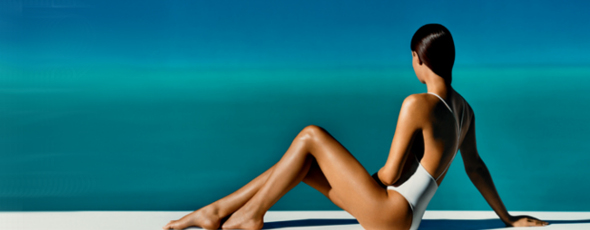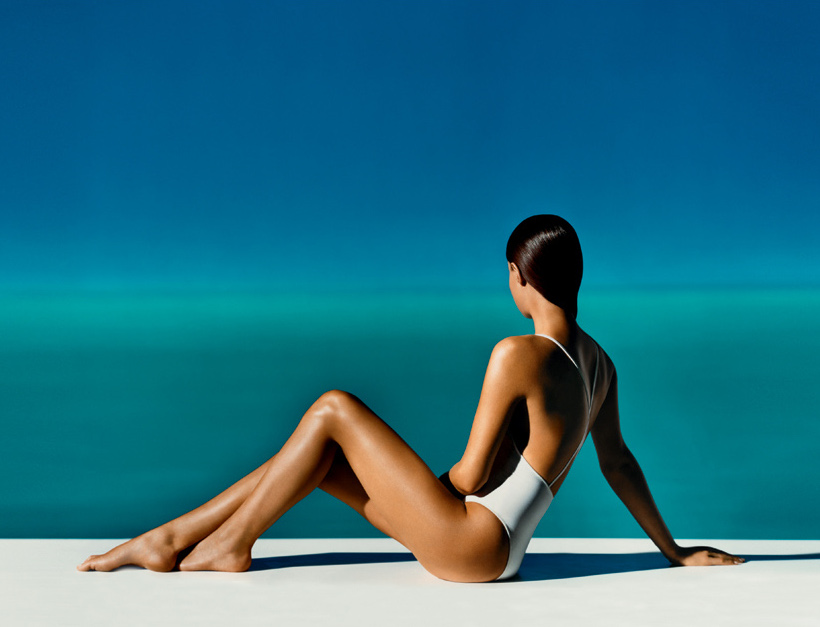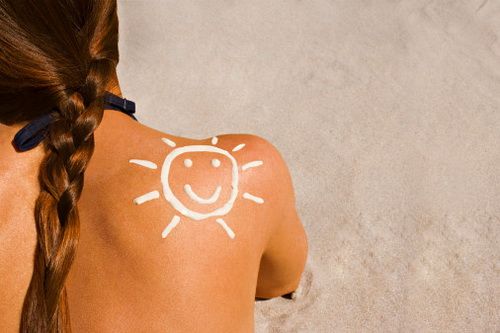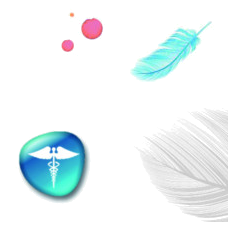Undoubtedly, living in sunny Greece is a major privilege. Exposure to solar radiation is beneficial for both mental and physical health as it enables vitamin D to be produced (we get small amounts of this vitamin from our diet, except for one we get large amounts from fish and fish oils). Nevertheless, there is a documented correlation that exposure to the sun (especially intermittent during the summer holidays) and the unpleasant experience of sunburn cause an increased incidence of skin cancer and especially the particularly malignant form which is melanoma.
The medical philosopher Hippocrates centuries ago argued that "prevention is the greatest cure," so it's especially helpful to sort the myths from the truth when it comes to our sun exposure.
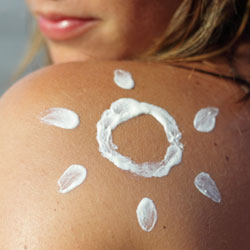
- Tanning is health. A deep tan protects us from the sun, like a natural sunscreen.
This is of course a myth. Yes, tanning is the body's own defense against damage caused by ultraviolet (UV) radiation, but tanning on white skin offers a Sun Protection Factor (SPF) of 4. Therefore, no tan is healthy. Light tanning may reduce the risk of burns, but there is still the risk of skin damage. In fact, tanning is not a sign of health, but of skin damage.
-We don't get sunburned when it's cloudy. We also don't get sunburned in the water.
Both are myths! 80% of solar ultraviolet (UV) radiation can penetrate a thin layer of clouds. The haze additionally increases (because of the illusion of safety, but also because of less heat perception) the exposure to ultraviolet (UV) radiation.
-Ultraviolet (UV) radiation in winter is not dangerous
It's wrong. In general, ultraviolet (UV) radiation is lower during the winter months, but reflection from snow can double total exposure especially at high altitude.
-Sunscreens protect and we can sunbathe for a longer period of time.
Sunscreens are not designed to increase the time of exposure to solar radiation, but to increase protection from solar radiation, which we cannot avoid. The protection they offer depends to a significant extent on their correct application.

- If we take breaks at regular intervals during sunbathing, we will not get a sunburn.
This is also a myth. Exposure to ultraviolet (UV) radiation during the day is cumulative.
-If we don't feel the hot rays of the sun we won't get a sunburn.
It's a myth. The heat we perceive (produced by the visible and infrared spectrum of solar radiation) has nothing to do with the risk of sunburn. Sunburn is caused by ultraviolet (UV) radiation, which is not perceptible.
-Artificial tanning with artificial tanning devices (solarium) is safe.
It's a myth. Artificial tanning devices cause tanning through ultraviolet A (UVA) radiation. UVA, although it tans without causing a sunburn, significantly increases the risk of skin cancer and without a doubt causes photoaging (premature aging of the skin). Also, the tan we get from exposure to these devices does not protect our skin from sunburn when we are exposed to sunlight, because sunburn is caused by ultraviolet B (UVB) radiation.
– Under the shade of the umbrella we are protected from sunburn
It's a myth. The sun's rays penetrate the umbrella more or less, depending on the fabric it is made of, as well as its color. Also, the sun reflects off the sand and water so it can find us even when you're quietly reading a book under an umbrella. Under an umbrella in an open environment such as the beach, we are still prone to sunburn from reflected UV radiation unless additional sun protection measures are applied.
- Our sunscreen products with a high protection index offer absolute protection from the sun. A sunscreen with an index of 50+ is better than another with an index of 30+
First of all, it is highly questionable whether the sunscreen is being used correctly. According to the clinical studies of the companies that produce them, the sunscreen should be applied half an hour before going out in the sun, in a thick layer of 2mg/cm2 (an adult in a swimsuit needs three tablespoons for the whole body, while we usually we use ¼ of this amount) and the application should be repeated every two to three hours (as time passes, sunscreens lose their effectiveness. Besides, even if the sunscreen says that it is water resistant, it must the application is repeated after swimming or if we sweat a lot). In real life conditions these conditions are rarely met. Second, the effectiveness of SPF above 30 (30 binds 97% of UVB when used in a thick layer) only increases by 1% or 2%. Furthermore, UVA, which accounts for more than 95% of solar radiation reaching the earth's surface, is not reflected in SPF. The phrase "broad spectrum" also implies protection from UVA, but there is no numerical rating of the protection it provides against it. Sunscreen products that only protect against UV-B radiation provide a false sense of security because they do not protect the skin from dangerous UV-A radiation.

Our clothes protect us from the harmful effects of sun exposure.
Is true. Clothing provides the best protection from intense solar radiation. Short sleeve blouses are comparatively better than sleeveless as well as densely woven garments. Prefer dense weaving. If you can see your fingers through the fabric, then the particular garment cannot protect your child from the sun. Cotton T-shirts provide less than 4 to 10 SPF protection. It is also a good idea to wear a wide-brimmed hat and good quality sunglasses (as UV rays are also harmful to the eyes). Today, special clothes for children, including swimwear, are available on the market, with an integrated sun protection index (index up to 50). But we must not forget that wet clothes lose half of the protection they provide (less than 3 SPF) against UV rays.
-We must avoid exposure to the sun during midday hours
It's correct. It is wise to avoid direct sun exposure, especially between 11:00 A.M. and 3:00 p.m

- Gradual tanning protects us from exposure to the sun.
It's correct. In general, the rule is that the skin should gradually get used to solar radiation. Skin that has gradually and continuously tanned can withstand UV radiation up to 10 times better than untanned skin. Everyone also needs to know the specific personal protection time that applies to their photograph (combination of skin color and hair color), in other words, the maximum permissible time of sun exposure without protection.
– The incidence of the most dangerous skin cancer, melanoma, has increased since the widespread use of sunscreens began
It's a myth. Melanoma increase unrelated to sunscreen Most melanoma patients have sunburned long before they start wearing sunscreen – and five sunburns per decade nearly triples the risk of developing melanoma. There are other possible explanations. In the beginning, with sunscreen people started to get more exposure to the sun. In addition, our diagnostic ability to diagnose melanoma has increased significantly over the past few decades.
– I got a tan, so I can stop wearing sunscreen
It's a myth. If our skin is tanned or we have naturally dark skin, this does not mean that we should be unprotected! The increased amount of melanin can protect us from sunburn, but not from the other negative effects of the sun, such as photoaging and skin cancer. So we are not allowed to remove our sunscreen.
-Sunscreen can make acne worse.
It's a myth. It can only be noticed if we use the wrong sunscreen. Patients with acne on the face and/or back or with oily, acne-prone skin should use special sunscreens. They should avoid very greasy creamy or oily compositions and sunscreens with natural filters. A sunscreen gel or spray with a clear texture is suitable for the body. For the face, a thin-flowing product that will state that it is "oil free" and "non comedogenic", suitable for oily or acne-prone skin, is preferable.
-Will I not tan if I wear sunscreen?
We will only tan if and as long as our photo allows. If we belong to phototype 1 or 2 (very fair skin), we will not tan, as our skin secretes a small amount of melanin. If we don't wear sunscreen, all we will do is turn red, even burn, and cause long-term damage to our skin.
-Will the redness on the skin turn into a tan?
It's a myth. Erythema (redness) heralds a "burn" and not a tan. The redness will remain just redness, while if you don't treat it properly, the skin at that point will peel off.
-The hair looks perfect after the sea and we don't want to wash it, are we doing it right?
The truth is, sea salt hair takes on a carefree, natural style that is often very flattering. However, salt dehydrates the hair to a great extent and combined with solar radiation the results are disastrous for the health of your hair. With prolonged exposure to the sun, hair breaks and fades. Gradually, they lose the appearance of health and radiance. They become brittle, while losing their elasticity Try to rinse your hair after swimming and wear a hat or scarf, so that it is not exposed to the sun for a long time. If you like to feel them freely on your shoulders, use a sunscreen spray or gel.
-Does melanoma only appear on parts of the body that are exposed to the sun?
It's a myth. Melanoma does not always appear on parts of the body that are exposed to the sun. It's a good idea to self-examine our skin often and see our dermatologist if you notice any changes.
-Using tanning spray tans our skin and thus we are not at risk from the sun?
It's a myth. Artificial tanning sprays and lotions contain DHA (d-hydroxyacetone) which, in contact with the skin, reacts with its amino acids and colors them artificially in the top layer of the skin. However, they do not provide protection against UV rays, so they must be used alongside sunscreen products. Using spray tans we essentially paint our skin. It plays no part in how your body protects itself from the sun. Fake tan products do not provide any protection from the sun.
Do we need a special sunscreen for the lips?
Is true. Our lips do not have melanin to protect them, unlike the rest of our body skin. This fact can cause problems such as burning, peeling and excessive dryness. It is therefore necessary to protect them from the sun with a sunscreen lipstick.

